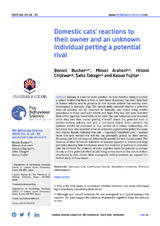Domestic cats’ reactions to their owner and an unknown individual petting a potential rival
Autor
Buchera, Benoit
Arahoria, Minori
Chijiiwaa, Hitomi
Takagia, Saho
Fujitaa, Kazuo
Editor
Universidad de Córdoba, Departamento de Medicina y Cirugía AnimalFecha
2020Materia
JealousyCats
Cat-human bonds
Secondary emotions
Stimulus enhancement
METS:
Mostrar el registro METSPREMIS:
Mostrar el registro PREMISMetadatos
Mostrar el registro completo del ítemResumen
Jealousy is a second-order emotion, its main function being to protect a valued relationship from a rival. A basic form of jealousy has been described in human infants, and its presence in non-human animals has recently been investigated in domestic dogs. The current study assessed whether a primitive form of jealousy can be observed in domestic cats tested using similar procedures to those used with infants and dogs. Fifty-two cats were recruited from either Japanese households or cat cafés. The cats’behaviors were recorded while they saw their owner petting a“social” object (i.e. potential rival: a realistic-looking soft-toy cat) and a non-social object (furry cushion). As jealousy should be expressed in the context of a valued relationship, cat behaviors were also recorded when an unknown experimenter petted the same two objects. Results indicated that cats -- especially household pets -- reacted more intensely toward the soft-toy cat previously petted by their owner. However, cats did not respond differentially toward the two human actors. The absence of other behaviors indicative of jealousy reported in infants and dogs precludes drawing firm conclusions about the existence of jealousy in domestic cats. We consider the existence of some cognitive bases for jealousy to emerge in cats, and the potential effect of cats’living environment on the nature of their attachment to their owner. More ecologically valid procedures are required for further study of these issues.

